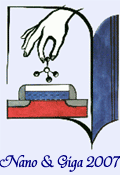
From Atoms to Materials to Devices to System Architecture
Symposium and Spring School (Tutorial Lectures)
Phoenix, Arizona, March 12-16, 2007

 |
Nano and Giga Challenges in Electronics and Photonics From Atoms to Materials to Devices to System Architecture Symposium and Spring School (Tutorial Lectures) Phoenix, Arizona, March 12-16, 2007 |
 |
|
|
Commentary
A carbon nanotube can be either semiconducting or metallic depending on its diameter and chirality. It was demonstrated in 1998 and 1999 that it is possible to fabricate field effect transistors (FET) and diodes made only by nanotubes and more recently it was shown that they can be used in logic gates. Carbon nanotubes can be also used as nanoscale wires in integrated circuits. Moreover carbon nanotubes behave as ballistic conductors when the applied voltage is low. Since they do not exhibit dangling bonds, nanoelectronic devices made by nanotubes can employ any insulator material with higher dielectric constant than silicon oxide. These discoveries make carbon nanotubes potentially suitable devices for future nanoelectronics. In the field of photonics devices, it has been demonstrated that carbon nanotubes can also be used as light sources. Nanotube-polymer composites can be used for light emitting diodes. Bundles of nanotubes can work as filaments in incandescent light bulbs and individual nanotubes can emit polarized light. Semiconducting nanotubes can be also used as a fluorescent agent for biological applications. An important issue for the use of carbon nanotubes in nanoelectronics and photonics is the possibility to distinguish the metallic and semiconducting nanotube and the determination of the structural parameters (diameter and chirality) for each individual nanotube. Optical techniques such as resonant Raman spectroscopy have been employed to characterize the structural and electronic properties of nanotubes. It is possible to obtain the Raman signal of just one isolated nanotube due to its extremely strong Raman cross- section. We have demonstrated in 1998 that it is possible to know if an individual nanotube is metallic or semiconducting from its Raman spectrum. More recently, we are using a resonant Raman map that can provide two fundamental properties of individual nanotubes (diameter and optical transition energy) that allows the structural characterization of individual nanotubes. This technique provides a non-destructive and fast characterization of different types of nanotube samples. As prospective nanosmaterial carbon nanotubes are considered as one of the most promising materials for nanoelectronics and nanophotonics and many researchers believe that one day they will substitute silicon. We still do not know when electronic and photonic devices made by nanotubes will be found in supermarkets, but I am convinced that this will happen in the future. I expect that the discussion about the use of carbon nanotubes in nanoelectronics and nanophotonics and the comparison of the performance of this material with other promising alternative materials will be a hot topic for discussions at NGC2007 conference in Arizona. |